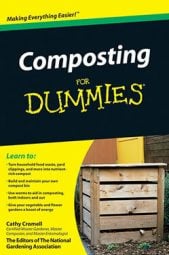Because there are so many types of composters on the market, finding the right one for you can be tricky. Compost containers (despite some of the marketing materials that accompany them) aren't magical devices whereby you drop in straw, wave your wand-like compost thermometer, and presto — out spills black gold! The basic needs of decomposer organisms must still be met, including an appropriate mix of carbon and nitrogen materials chopped into small pieces, moisture and aeration during the process, and sufficient mass to build up and retain temperature levels. Your efforts in meeting these requirements favor the types of mesophilic and thermophilic organisms that do the bulk of the composting work.
Considering these options when choosing a container:
Size: Keep in mind that a container's size is often the limiting factor in its ability to produce compost quickly. If the container holds less than 1 cubic yard (1 cubic meter) of materials (the minimum size for efficient decomposition), you can still work with it. But you need to manage the contents, air, moisture, and temperature more regularly if you want speedy compost, just as you would with a freestanding pile or homemade bin. If you're in no hurry and just want a tidy receptacle to contain a relatively small amount of organic leftovers, then container size is not as important a factor.
Weight: If it's a tumbler, you want to be able to easily rotate it when it's full of heavy, wet organic matter. If it's not a tumbler, and you use just one container, it's nice to be able to lift it up and off the organic matter to set it aside for turning or reloading.
Height: Make sure you can easily lift your pitchfork or shovel loaded with organic materials into the container. It's typically less fatiguing to rest your pitchfork or shovel on the side of the container as you empty it, rather than to hoist it upwards above shoulder level.
Assembly required: Most bins require some assembly. Connectors such as screws or bolts usually hold up longer than plastic tabs that crack or break after a season or two in extreme weather. Look for sturdy, rigid construction at joints. Loose connections can come apart and cause the container to collapse when you're poking around in the bin.
Lids: Look for sufficiently large top openings to add fresh organic matter. Will your loaded-up pitchfork or shovel fit with room to spare? Or do you need to use your hands to stuff materials in?
Pest deterrents: Lids should tighten securely to protect against enterprising pests and strong winds. At the same time, you want to be able to lift lids to add more organic matter without a lot of fuss.
Access panels: Some units offer sliding trap doors at the bottom to provide access to the finished compost. Check the dimensions to see whether your spade will fit inside. Otherwise, you'll need to scoop compost out by hand or use a hand trowel.
Aeration and drainage holes: Air and water are important ingredients in composting. If bins are fully enclosed, there must be some method for allowing air in and moisture out. Without drainage, the contents of the container turn wet and stinky and the decomposition process slows.

